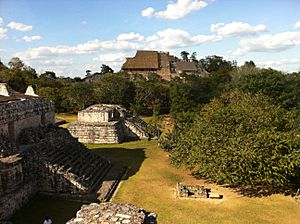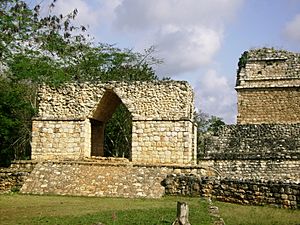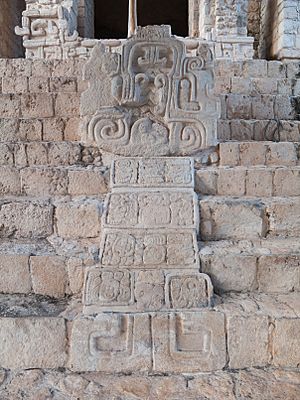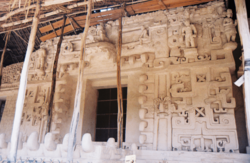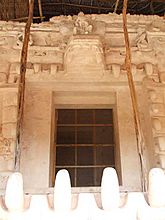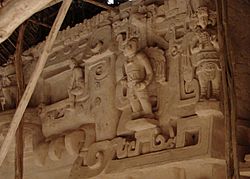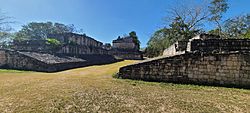Ekʼ Balam facts for kids
Ekʼ Balam (say it like "ek bal-am") is an ancient Maya city in Yucatán, Mexico. It's about 25 kilometers (15 miles) north of Valladolid. This amazing place was once the center of a powerful Maya kingdom.
One of the coolest things about Ekʼ Balam is how well preserved some of its buildings are. Especially famous is the plaster on the tomb of Ukit Kan Lek Tokʼ. He was a king buried inside the biggest pyramid.
Contents
History of Ekʼ Balam
Ekʼ Balam was lived in for a very long time. People were here from around 700 BC all the way to the 1500s AD. It grew into a big city and became the capital of its region around the time of Jesus's birth.
The city was most powerful between 770 and 840 AD. During this time, Ekʼ Balam was a very important place. It helps us learn a lot about other Maya cities in the north. This is because many other northern Maya sites are not as well preserved.
After its peak, the number of people living in Ekʼ Balam dropped a lot. The city slowly became empty. Scientists have different ideas about why people left. Some think it was abandoned quickly, perhaps due to attacks.
We know about Ekʼ Balam from old Spanish records from the 1500s. These records say it was part of a kingdom called 'Talol'. This kingdom was started by a ruler named Ekʼ Balam. Later, another powerful family, the Cupul family, took control of the area.
Amazing Architecture
Ekʼ Balam has 45 different buildings and structures. Here are some of the most important ones:
- Defensive Walls: These walls protected the city. They ended at a very steep sinkhole, making it hard for enemies to get in.
- Entrance Arch: This arch stands at the city's entrance. It was likely used for special ceremonies.
- Oval Palace: This building held ancient burial items. Its design might have been connected to Maya beliefs about the universe.
- Structure 17 (The Twins): This building has two matching temples on top.
- Chapel: A smaller, special building.
- Carved Stela: This is a tall stone monument with carvings. It probably shows a ruler of Ekʼ Balam, maybe even King Ukit Kan Leʼk Tokʼ.
- Structure 12: Another important building.
- Structure 10: This platform was first built a long time ago. Later generations added to it.
- Structure 7: One of the many structures in the city.
- Ballcourt: This is where the Maya played their famous ballgame. It was finished in 841 AD.
- Structure 2: This is a large platform on the west side of the Acropolis. It has a temple on one corner.
- Steam Bath: The Maya used these for cleansing rituals.
- Structure 3: This unexcavated platform is on the east side of the Acropolis. It borders the main plaza.
- Structure 1 (The Acropolis): This is the biggest building at Ekʼ Balam. It's believed to hold the tomb of Ukit Kan Leʼk Tokʼ. Digging here started in 1998.
- El Trono (The Throne): This is the temple where King Ukit Kan Leʼk Tokʼ was buried. The entrance looks like a giant monster mouth, possibly a jaguar.
Cool Features of Ekʼ Balam
Defensive Walls
The city of Ekʼ Balam was surrounded by two big walls. These walls helped protect the city from attacks. There were also smaller walls inside the city. The inner wall was about 2 meters (6.5 feet) tall and 3 meters (10 feet) wide. It was covered in plaster. The outer wall was mainly for defense. These walls were some of the largest in the Yucatan during the Late Classic period. They showed how strong and protected the city was. Some theories suggest the city was abandoned quickly. This idea is supported by a fourth wall inside the city. This wall was poorly built and cut across the main plaza. It seems like a last-minute attempt to protect against invaders.
Buildings Inside the Walls
Only the central part of Ekʼ Balam has been dug up by archaeologists. Large, raised platforms line the inner wall. They surround open areas called plazas. Special roads called sacbés lead out from the center in four directions. These roads were likely considered sacred. They also showed the Maya idea of a "four-part cosmos" or universe. The buildings here were built in a style similar to other big Maya cities of that time.
The Acropolis building holds the tomb of King Ukit Kan Leʼk Tok'. He ruled Ekʼ Balam from 770 to 797 or 802 AD. This was during the city's most powerful time.
Ancient Wall Paintings
Inside the rooms of the Acropolis, archaeologists found amazing wall paintings. Some of these paintings include texts, like the 'Mural of the 96 Glyphs'. This is a masterpiece of Maya writing. Another painting shows a mythological scene with a hunted deer. This might tell a story about how death began. Other paintings on the ceiling stones show a lightning god. These special decorations are also found at other Maya sites.
Archaeological Discoveries
Ekʼ Balam was first explored by an archaeologist named Désiré Charnay in the late 1800s. But serious digging didn't start until about 100 years later. Bill Ringle and George Bey III mapped the site in the late 1980s. They continued their research into the 1990s. Their work has been very important for others studying Ekʼ Balam. Later, Leticia Vargas de la Peña and Víctor Castillo Borges dug up the Acropolis. Alfonso García-Gallo Lacadena helped read and understand the Maya hieroglyphic texts found at the site. All we know about Ekʼ Balam's history comes from his work.
Gallery
-
Stucco jaws principal pyramid of Ek Balam(Yucatan)
See also
 In Spanish: Ek Balam para niños
In Spanish: Ek Balam para niños


